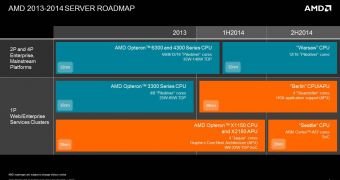While Intel is making full use of the bragging rights that come with a new Xeon Phi coprocessor collection and the strongest ever supercomputer, AMD is making some noise of its own.
Not much though. Unlike on some previous occasions, when it was its CPUs, not Intel's, that led the charge, AMD doesn't have some huge success to talk about now. That is why it is looking to the future instead.
Long story short, AMD has posted the roadmap for the server portfolio that will debut between now and the end of 2014.
“Our strategy is to differentiate ourselves by using our unique IP to build server processors that are particularly well matched to a target workload and thereby drive down the total cost of owning servers,” said Andrew Feldman, general manager of the server business unit, AMD.
“This strategy unfolds across both the enterprise and data centers and includes leveraging our graphics processing capabilities and embracing both x86 and ARM instruction sets.”
One of the upcoming server platforms is called Warsaw and it is made for two- and four-socket enterprise servers. It will provide better performance-per-watt than today’s AMD Opteron. It will come out in Q1 2014.
Another processor, called Berlin, will come in both CPU and APU versions (Steamroller) and will manage 8 times the gigaflops per-watt performance of the current AMD Opteron 6386SE processor. It will be the first server APU built on AMD’s revolutionary Heterogeneous System Architecture (HSA). It will arrive in 1Q or 2Q 2014.
Finally, Seattle, the industry’s only 64-bit ARM-based server SoC, will have 8 or 16 cores (ARM Cortex-A57) and will work at 2 GHz or more. Performance will be 2-4 times that of AMD’s recently announced AMD Opteron X-Series. Samples will ship in 1Q 2013, with mass production set for 2H 2014.
Seattle will also be the first to use AMD’s advanced Freedom Fabric and will have 128GB DRAM support, server caliber encryption, and compression and legacy networking including integrated 10GbE, among other things.

 14 DAY TRIAL //
14 DAY TRIAL //